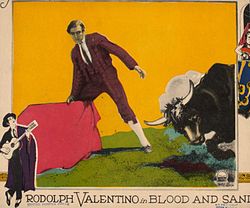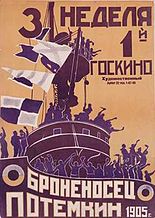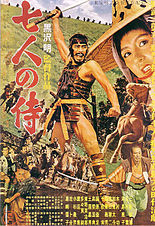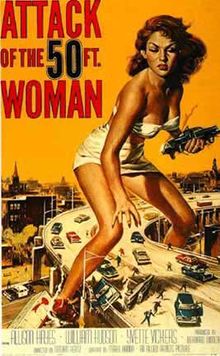- Film poster
-
A movie poster is a poster used to advertise a film. Studios often print several posters that vary in size and content for various domestic and international markets. They normally contain an image with text. Today's posters often feature photographs of the main actors. Prior to the 1990s, illustrations instead of photos were far more common. The text on movie posters usually contains the film title in large lettering and often the names of the main actors. It may also include a tag line, the name of the director, names of characters, the release date, etc.
Movie posters are displayed inside and on the outside of movie theaters, and elsewhere on the street or in shops. The same images appear in the film exhibitor's pressbook and may also be used on websites, DVD (and historically VHS) packaging, flyers, advertisements in newspapers and magazines, etc.
Movie posters have been used since the earliest public exhibitions of film. They began as outside placards listing the programme of (short) films to be shown inside the hall or movie theater. By the early 1900s, they began to feature illustrations of a scene from each individual film or an array of overlaid images from several scenes. Other movie posters have used artistic interpretations of a scene or even the theme of the film, represented in a wide variety of artistic styles.
Contents
History
 Rudolph Valentino in Blood and Sand, 1922
Rudolph Valentino in Blood and Sand, 1922
Originally, movie posters were produced for the exclusive use by the theatres exhibiting the film the poster was created for, and the copies of the posters were required to be returned to the distributor after the film left the theatre. In the United States, movie posters were usually returned to a nation-wide operation called the National Screen Service (NSS) which printed and distributed most of the film posters for the studios between 1940 and 1984. As an economy measure, the NSS regularly recycled posters that were returned, sending them back out to be used again at another theatre. During this time, a film could stay in circulation for several years, and so many old movie posters were badly worn before being retired into storage at an NSS warehouse (most often, they were thrown away when they were no longer needed or had become too worn to be used again). Those posters which were not returned were often thrown away by the theatre owner, but some movie posters found their way into the hands of collectors.[citation needed]
Beginning in the 1980s, the American film studios began taking over direct production and distribution of their posters from the National Screen Service and the process of making and distributing movie posters became decentralised in that country.[citation needed]
Collecting
The collecting of movie memorabilia began with such things as scrap-books, autographs, photographs, and industry magazines, but quickly expanded in the post-World War II era. Collectors began seeking out original advertising material, and the classic "one sheet" movie poster became the pinnacle object to own for any given film. Other material, such as lobby cards, other-sized posters, international posters, personality posters, and glass slides also began to become highly sought after. Today, the field of movie memorabilia collecting has grown into an internationally recognised community of increasingly serious and financially secure collectors, making it one of the fastest areas of speculation for investment.[citation needed]


The Battleship Potemkin, 1925 After the National Screen Service ceased most of its movie poster printing and distribution operations in 1985, some of the posters which they had stored in warehouses around the United States ended up in the hands of private collectors and movie poster dealers. Today there is a thriving collectibles market in movie posters. Some have become very valuable among collectors, with a few rare examples being auctioned for US$500,000 or more. The record price for a poster was set on November 15, 2005 when US$690,000 was paid for a poster of Fritz Lang's 1927 film Metropolis from the Reel Poster Gallery in London.[1] Other early horror and science fiction posters are known to bring tremendous prices as well, with an example from The Mummy realizing $452,000 in a 1997 Sotheby's auction,[1] and posters from both The Black Cat and Bride of Frankenstein selling for $334,600 in various Heritage Auctions.[2] The 1931 Frankenstein 6-sheet poster, of which only 1 copy is known to exist, is considered to be the most valuable movie poster in the world.[citation needed].
As a result of market demand, some of the more popular older movie posters have been reproduced either under license or illegally. Although the artwork on reproductions is the same as originals, reproductions can often be distinguished by size, printing quality, and paper type. Several websites on the Internet offer "authentication" tests to distinguish originals from reproductions.
Original movie posters distributed to theaters and other poster venues (such as bus stops) by the movie studios are never sold directly to the public. However, most modern movie posters are produced in large quantities and normally become available for purchase by collectors indirectly through various secondary markets such as Ebay. Accordingly, most modern posters are not rare. However, some recent posters, such as the recalled Pulp Fiction "Lucky Strikes" United States one sheet poster, are quite rare and valuable.
Types of movie posters
Lobby cards
 A lobby card of a 1921 Mary Pickford film.
A lobby card of a 1921 Mary Pickford film.
Lobby cards are like posters but smaller, usually 11 × 14 in (28 × 36 cm), also 8 × 10 in (20 × 25 cm) before 1930. Lobby cards are collected and their value depends on their age, quality and popularity. Typically issued in sets of eight, each featuring a different scene from the film. In unusual circumstances, some releases were promoted with larger (12 cards) or smaller sets (6 cards). "The Running Man" set, for example had only six (6) cards, whereas the earlier classic "The Italian Job" set spanned twelve photographs. Films released by major production companies experiencing financial difficulties sometimes had no accompanying "lobby set" at all. Perhaps one of the most notable examples of this scenario would be Michael Mann's cult classic Manhunter (1986), for which no USA lobby card set was ever printed. Notably, there was also no 10" x 8" colour set of cards for John Carpenter's cult horror classic Halloween (1978)
In the United Kingdom, sets of lobby cards are more typically referred to as "Front Of House" cards. However, this can sometimes also refer to black and white press photographs—in addition to the more typical 8 × 10 inch lobby card style promotional devices.
The Beinecke Rare Book and Manuscript Library at Yale University holds a collection of lobby cards from silent western films that date between 1910 and 1930.[3]
A teaser poster or advance poster is an early promotional movie poster, containing a basic image or design without revealing too much information such as the plot, theme, and characters. The purpose is to incite awareness and generate hype for the film. A tagline may be included. There are some instances when teaser posters are issued long in advance before the film goes into production, although they are issued during the film development.
Character posters
For a film with an ensemble cast there may be a set of character posters, each featuring an individual character from the film. Usually it contains the name of the actor/actress, with or without the name of the character played. It may also include a tagline that reflects the quality of the character.
Motion posters
The most recent type of poster in which the poster is animated.
Remix posters
A poster that has been altered or "remixed" to change the intent of the original movie poster. A remixed poster often contains a political or comedic message, using the credibility of the movie poster format to deliver the message of whoever is creating the remixed poster.
Film poster sizes


Seven Samurai (1954) Movie posters come in different sizes and styles depending on the country. The most common are listed below.[4]
United States
Note: In the United States motion pictures are normally referenced as "movies." The word "film" is far less common and generally used only to refer to an "art house" or foreign production. Accordingly, in the United States, and most English-speaking countries, promotional posters are almost always referenced as "movie posters" rather than "film posters."
- One sheet, 27 inches by 40 inches (686x1020mm), portrait format
- Bus stop, 40 inches by 60 inches (1016mm x 1524mm), portrait format
The following sizes were in common use in the United States prior to the mid-1980s, but have since been phased out of production:[citation needed]
- One sheet, 27 inches by 41 inches (686x1040mm), portrait format (this size is one inch longer than the modern One sheet)
- Display (aka Half-sheet), 22 inches by 28 inches (559x711mm), landscape format
- Insert, size 14 inches by 36 inches (356x914mm), portrait format
- Window Card, 14 inches by 22 inches (356x559mm), portrait format; typically has blank space at top to accommodate promotional text for local theatre
- Two sheet, 41 inches by 54 inches (1040x1370mm), either landscape format or portrait format
- Three sheet, 41 inches by 81 inches (1040x2060mm), portrait format; usually assembled from two separate pieces
- 30x40, 30 inches by 40 inches (762x1016mm), portrait format[5][6]
- 40x60, 40 inches by 60 inches (1016x1524mm), portrait format[5][6]
- Six sheet, 81 inches by 81 inches (2060x2060mm), a square format; usually assembled from four separate pieces
- Twenty four sheet, 246 inches by 108 inches (6250x2740mm), landscape format often called a billboard
United Kingdom
- Quad, size 30 inches by 40 inches (762x1020mm), landscape format
- Double crown, size 20 inches by 30 inches (508x762mm), portrait format
- One-sheet, size 27 inches by 40 inches (686x1020mm), portrait format
- Three sheet, size 40 inches by 81 inches (1020x2060mm), portrait format
Australia
- Daybill, size 13 inches by 30 inches (330x762mm), portrait format (before the 1960s, Daybills were 36 inches long)
- One sheet, size 27 inches by 40 inches (686x1040mm), portrait format
Billing block
Main article: Billing (filmmaking)The credits for the film that appear in condensed type on contemporary film posters and other advertising copy are referred to as the billing block.
Notable movie poster artists
Normally, the artist is not identified on the film poster and, in many cases, the artist is anonymous. However, several artists have become well-known because of their outstanding illustrations on movie posters, including the following. Indeed, some artists, such as Drew Struzan, often sign their poster artwork and the signature is included on distributed posters.
- Richard Amsel
- Examples: Raiders of the Lost Ark, The Sting
- Saul Bass
- Examples: Vertigo, The Shining
- Reynold Brown[2]
- Examples: Attack of the 50 Foot Woman, Creature from the Black Lagoon, The Incredible Shrinking Man, The Time Machine[3]
- Tom Chantrell
- Examples: Von Ryan's Express, Zulu Dawn, The Land That Time Forgot
- Frank Frazetta
- Examples: What's New Pussycat?
- Bill Gold
- Examples: Casablanca, A Clockwork Orange, For Your Eyes Only
- Mitchell Hooks
- Examples: Dr. No, The Sand Pebbles, El Dorado.
- The Brothers Hildebrandt
- Examples: Star Wars Episode IV: A New Hope ("Style B" re-release),[7] Barbarella (1979 re-release)
- Tom Jung
- Examples: Star Wars (Style A), The Empire Strikes Back (Style B),Papillon,The Lord of the Rings,Gone With The Wind (re-release)
- Frank McCarthy[8]
- Examples: The Ten Commandments, The Train, The Dirty Dozen, On Her Majesty's Secret Service
- Robert McGinnis[9]
- Examples: Casino Royale, Breakfast at Tiffany's
- Bob Peak
- Examples: Our Man Flint, Camelot, Apocalypse Now, The Spy Who Loved Me
- John Solie
- Examples: Shaft's Big Score, Capone[10]
- Drew Struzan
- Examples: Star Wars, E.T: The Extra-Terrestrial, Indiana Jones, Back to the Future, The Thing, Jurassic Park, Harry Potter and the Sorcerer's Stone
European movie poster artists
- France
- Boris Grinsson
- Jean Mascii
- Yves Thos
- Italy
- Anselmo Ballester
- Alfredo Capitani
- Renato Casaro
- Averado Ciriello
- Renato Fratini
- Luigi Martinati
- Spain
- Macario Gomez
Awards
The annual Key Art Awards, sponsored by The Hollywood Reporter, include awards for best movie poster in the categories of comedy, drama, action adventure, teaser, and international film. The Hollywood Reporter defines the term "key art" as "the singular, iconographic image that is the foundation upon which a movie's marketing campaign is built."[11] In 2006, the original poster for The Silence of the Lambs was named best film poster "of the past 35 years".[12]
References
- ^ a b "Lang movie poster fetches record". BBC News. 2005-11-15. http://news.bbc.co.uk/2/hi/entertainment/4438948.stm. Retrieved 2009-01-11.
- ^ [1]
- ^ The Western Silent Films Lobby Cards Collection, 1910-1930. Beinecke Rare Book and Manuscript Library at Yale University. Retrieved on 2009-07-08.
- ^ Movie Poster Art Gallery - Glossary Sizes Accessed 06/Dec/2007
- ^ a b MovieArt.net
- ^ a b AllMovieReplicas.com
- ^ "Tim Hildebrandt". Posterwire.com. June 13, 2006. http://posterwire.com/archives/2006/06/13/tim-hildebrandt/. Retrieved 2009-03-16.
- ^ "Frank McCarthy". American Art Archives. http://www.americanartarchives.com/mccarthy,f.htm. Retrieved 2009-01-11.
- ^ "Robert McGinnis". American Art Archives. http://www.americanartarchives.com/mcginnis.htm. Retrieved 2009-01-11.
- ^ http://www.johnsolie.com/?dir_cat=29061
- ^ "Key Art Awards press release" (Press release). Movie City News. 2003-06-23. http://www.moviecitynews.com/Notepad/2003/030623_pr.html. Retrieved 2009-01-11.
- ^ 'Sin City' place to be at Key Art Awards Hollywood Reporter. Retrieved 2007-10-07
External links
- AllPosterForum.com: Forum for movie poster collectors (founded 2009)
- Filmfan.com: The Internet's first movie poster forum (founded 1995)
- IMPAwards.com: Movie poster images, and annual awards
- MoviePosterCollectors.com: Reference, authentication, and showcase website
- MoviePosterForum.com: Discussion and Authentication (founded 2005)
- MPDB.com: Movie poster database and images
- MPoster.com: Movie poster images
- Not Strictly For General Exhibition: Discussion forum (founded 2005)
- Yale Beinecke Library Western Silent Films Lobby Cards Collection, 1912-1930
Categories:- Film advertising material
- Posters
- Film and video terminology
Wikimedia Foundation. 2010.


